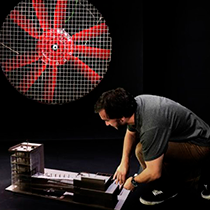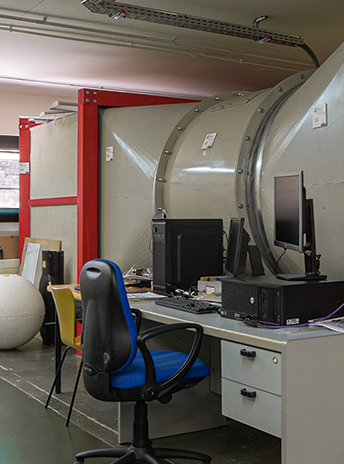2
Two test faces, one high speed 40 m/s and one low speed 10 m/s, square sections of 90 cm edge and 180 cm respectively.
36 Kw
36 Kw three-phase engine to propel wind
Closed horizontal axis wind tunnel that occupies a space of 12 x 5.6 m2, has 2 test chambers a high speed of 0.9 x 0.9 m2 and another low speed one of 1.80 x 1.80 m2, with maximum wind speeds of 150 and 50 Km/h, respectively.
With this device, students better understand the effects of wind on objects; measuring the forces objects are subjected to, the wind speed and visualizing air current lines. The objects can be models of aeroplanes, cars, aeroplane wings, buildings, bridges or any object subjected to the force of wind; wind turbines can also be tested for efficiency.
With these practices, the behaviour of a body subjected to the wind can be better understood and its design can be improved in order to optimise the forces to which it is subjected.
It is also used by the Air and Motor clubs to test their own designs.
A space where wings designed by our students are tested by measuring lift and aerodynamic resistance. Aerodynamics tests are also carried out to support final projects for the Bachelor’s Degree in Aerospace Engineering in Aircraft and the Master’s Degree in Aeronautical Engineering; the effects of wind on structures in the Bachelor's Degree of Civil Engineering and models for the Bachelor's Degree in the Fundamentals of Architecture; or, for example, final projects on vertical axis wind turbines.
Collaborative work also takes place with companies, where our students can have their first experiences in projects that are in demand in the business environment.
Wind tunnel, what is it? What is it used for?
Wind tunnel features:
- Two test faces, one high speed 40 m/s and one low speed 10 m/s, square sections of 90 cm edge and 180 cm respectively.
- Dynamometers for measuring force.
- Scanivalve Multi Pitot Tube.
- Hot wire anemometers.
- Smoke equipment for streamline visualization.
- Computers, one for wind tunnel 36 Kw engine management.
- Another for acquiring dynamometer data.
- Photo and video cameras for recording tests.

Agreement with Airbus
The current wind tunnel has wakened interest of multinationals such as the aircraft manufacturer Airbus. The Universidad Europea has came to an agreement with the multinational based in Toulouse (France) to begin testing some of its prototypes.

